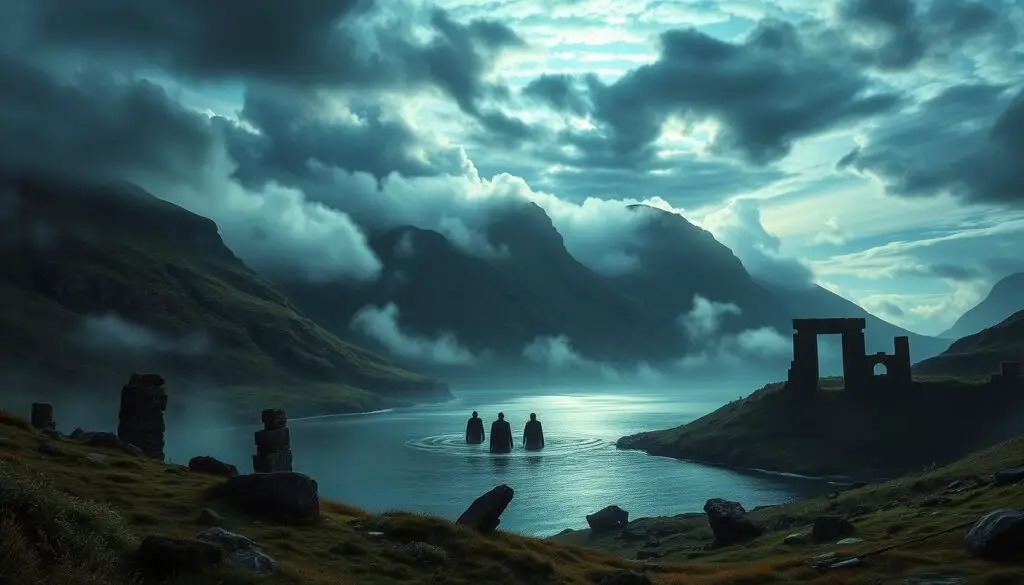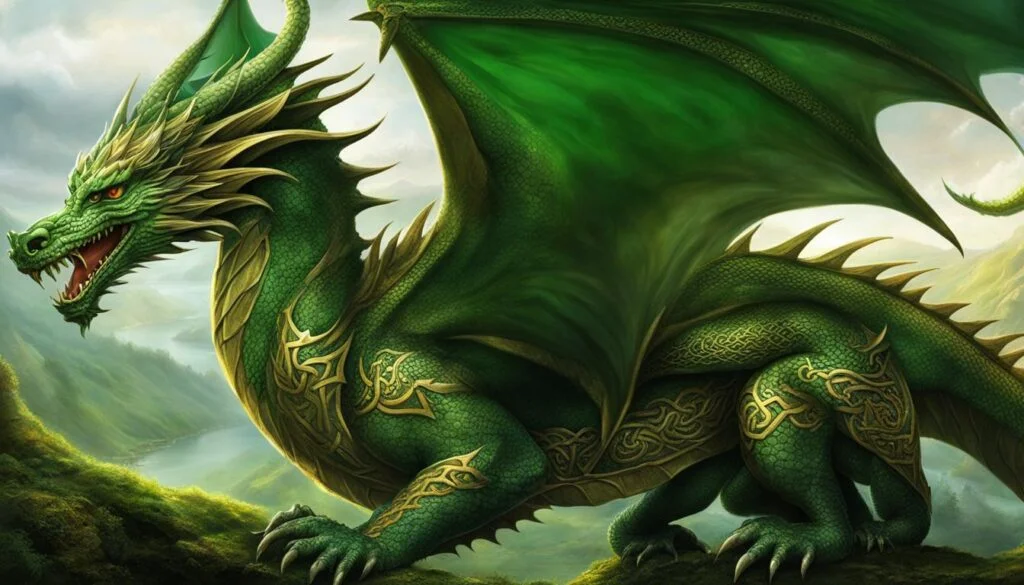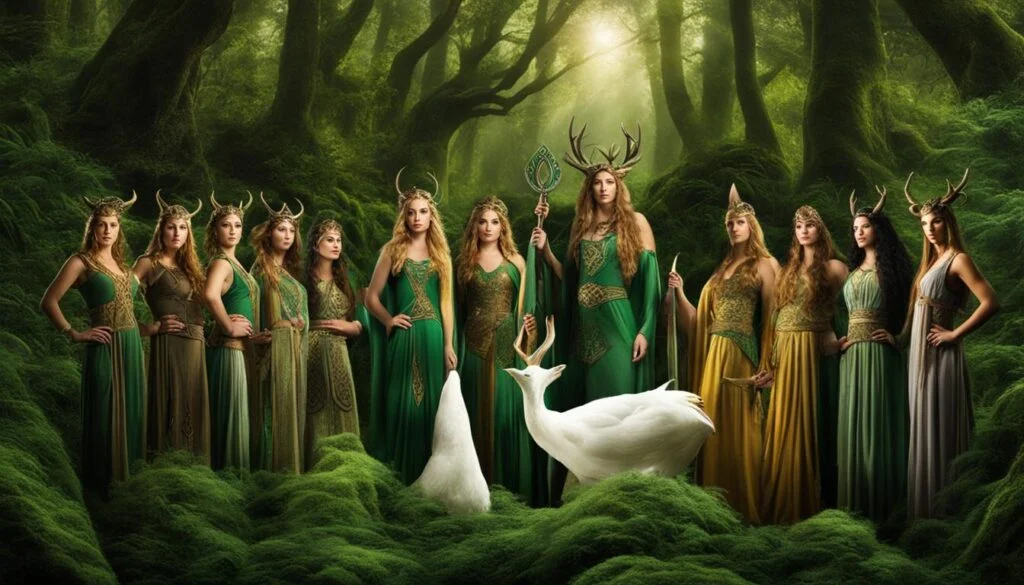The Fomori are mysterious beings from Irish myths, seen as a race of fierce and monstrous beings from the sea or earth.
They play a dark role in ancient stories, fascinating many with their unique place in folklore.
These creatures are seen as supernatural beings, bringing chaos and darkness. They show the wild side of nature.
Over time, the Fomori have changed in stories. They started as sea spirits, then became sea raiders because of Viking attacks.
Later, they were seen as giants in some tales.
Cichol Gricenchos, for example, brought plagues, showing how far the Fomori could go.
Their stories mix with the heroic tales of the Tuatha Dé Danann, especially in the Battle of Mag Tuired.
Today, these stories are still told, showing the Fomori as symbols of chaos in stories and art.
The stories of the Fomori add depth to Irish myths, telling of epic battles like Lugh’s rebellion against Bres, a half-Fomor.
They also tell of unique characters like Elatha, a prince with golden hair who didn’t fit the usual Fomor image.
These stories keep drawing in readers, showing the lasting charm of these legendary beings.
Key Takeaways
- The Fomori are enigmatic figures in ancient Irish mythology, known for their roles as supernatural entities embodying chaos and destruction.
- Their portrayal has evolved over time, reflecting influences such as Viking raids and shifting from underwater spirits to giants.
- Notable stories involve their epic battles with the Tuatha Dé Danann, especially during the famous Battle of Mag Tuired.
- Key figures include Cichol Gricenchos, who led with pestilent plagues, and Elatha, a just and handsome prince breaking the mold of typical Fomorian depictions.
- Explorations of Fomorian legends continue to influence literature and art, preserving their legacy as legendary beings in Irish folklore.
Introduction to Fomori: Origins and Etymology
The origins of the Fomorians in Celtic mythology are truly captivating. The name “Fomorian” comes from Old and Middle Irish.
It shows their dark and mysterious nature. Their name’s deep roots in mythological etymology add to their enigmatic character.
Roots in Old Irish Language
The term “Fomorian” has two parts: “fo,” meaning “under” or “beneath.” The second part is a topic of debate among scholars.
Some believe it means “sea,” linking them to the water in Irish legends.
Others think it could mean “demons” or “giants,” highlighting their monstrous side.
Meaning and Interpretations
There are different views on what the name “Fomorian” means, reflecting various roles in Celtic mythology.
Scholars like Marie-Louise Sjoestedt see them as connected to darkness and the underworld. This fits with their image as evil spirits from the sea and underworld.
Theories on Their Origin
Many theories exist about where the Fomorians came from. One idea is they were ancient gods of chaos in the Mediterranean, later added to Irish stories.
Another theory is they symbolized the wild, untamed parts of nature.
Despite these different views, most scholars agree they are linked to the underworld. This shows their power and destructive nature.
The Mythological Cycle and the Fomori
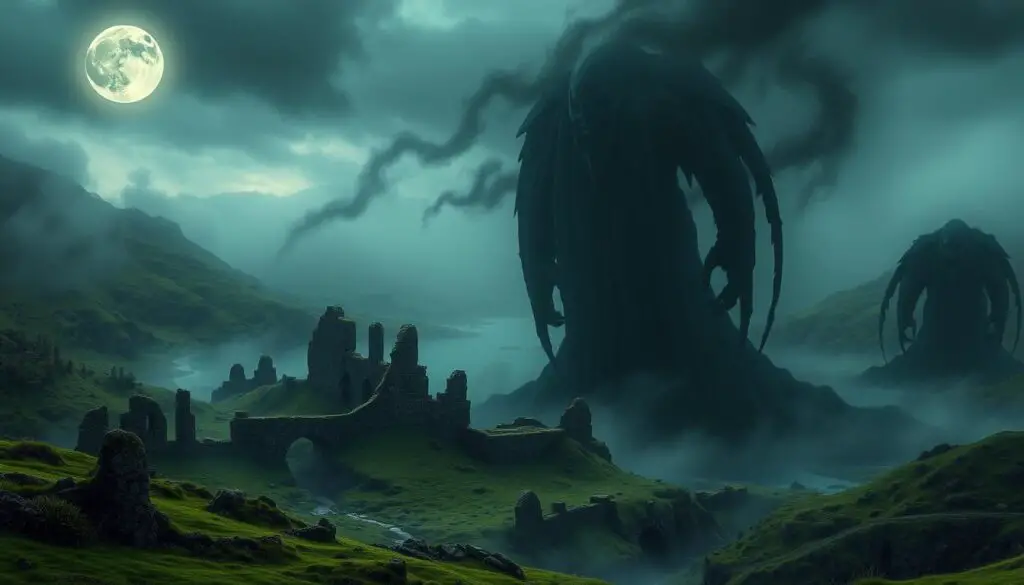
The Fomorians play a big part in the Irish Mythological Cycle. This is a collection of stories and poems about supernatural beings in Ireland before history.
They mix with tales of the first settlers and other legendary groups.
The word “Fomori” means ancient enemies, showing them as strong foes to the early people.
Early References in Irish Mythology
The Fomorians are seen as a scary and evil race in Irish myths. They come from the sea or the earth and fight against invaders.
The first people in Ireland, like Partholón and Nemed’s groups, faced the Fomorians in many battles.
These stories tell of big struggles and conflicts in Ireland’s mythological world.
Role in the Lebor Gabála Érenn
The Lebor Gabála Érenn, or “Book of Invasions,” tells of many invasions and settlements.
It says the Fomorians always fought against the new settlers. They clashed with the Tuatha Dé Danann in the Battle of Mag Tuired, a key event in these stories.
This battle shows the fight between order and chaos. It’s part of a wider myth tradition, where different groups battle for control of the land.
The Fomorians are key to Ireland’s mythological history. They show the conflicts and themes that shaped Ireland’s legendary past.
Their battles with the first settlers and their part in the Lebor Gabála Érenn highlight their importance in Irish myths.
Physical Descriptions and Characteristics of the Fomorians
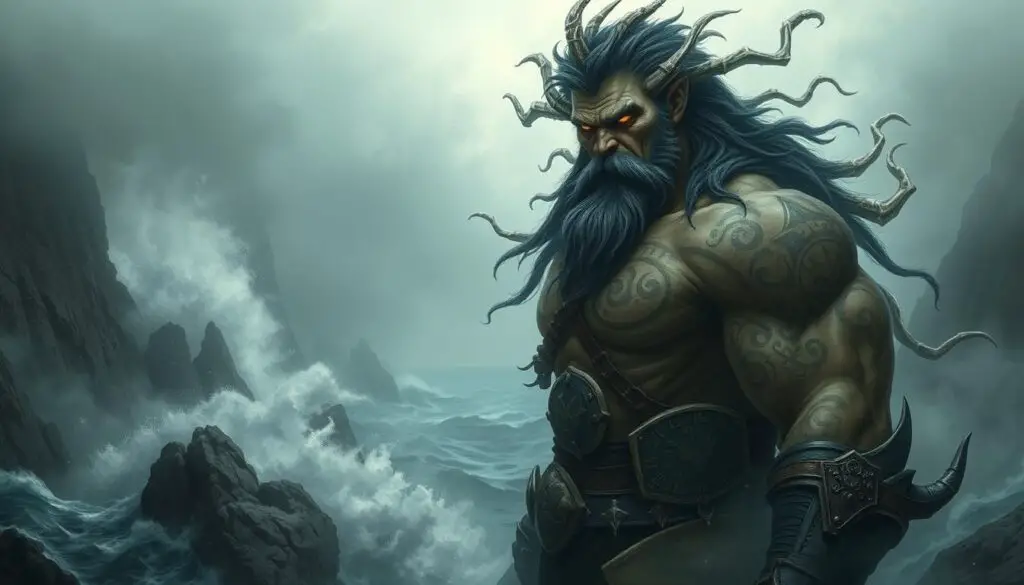
The Fomorians are among the most unique and monstrous creatures in Irish myths.
They stand out in the world of mythical beings because of their eerie looks.
Monstrous Appearances
In Irish myths, Fomorians are often seen as monstrous with interesting features.
They are described as having a man’s body but a goat’s head. This mix of human and animal traits shows their otherworldly nature.
Descriptions of Fomorians vary a lot. Some say they are evil spirits living under the sea.
Others see them as powerful sea raiders. These different stories show their wide impact in myths.
Notable Features: One Eye, One Arm, One Leg
The Fomorians are often imagined as one-eyed giants. They have one eye, one arm, and one leg.
These odd features make them look scary and mysterious.
Even though they’re seen as brutal, some Fomorians, like Elatha and Bres, are described as darkly beautiful.
This shows they can look both monstrous and strangely beautiful.
Looking into Fomorian descriptions, we see they’re more than just scary creatures.
They’re key symbols in ancient stories. They represent the wild and mysterious forces of nature from long ago.
The Fomori as Sea Raiders and Giants
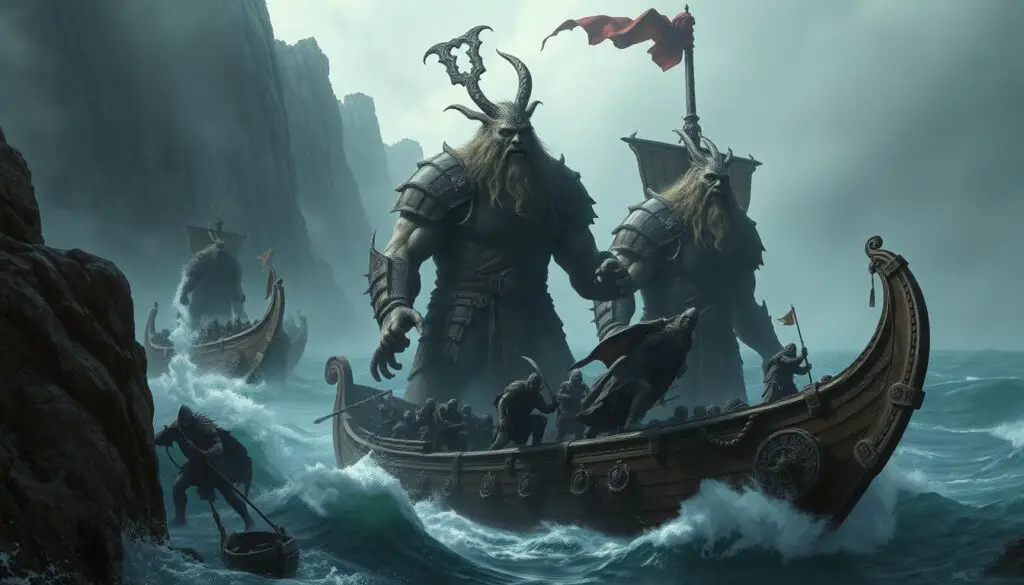
The Fomorians, or Fomori giants, came from mysterious places under the sea or deep in the earth.
They are often seen as fierce and monstrous beings. Their story as sea raiders comes from Viking times, as old stories show.
Geoffrey Keating’s 17th-century History of Ireland links them to a seafaring people from Noah’s son, Ham.
Influence of Viking Raids
The Viking invasions of Ireland in medieval times greatly shaped the Fomorians’ image.
These raids were known for their terror. They left a lasting impact on Irish stories and memories.
So, the Fomorians became seen as evil sea raiders. They inspired both fear and wonder.
This mix of real Viking stories and myths made the Fomori fascinating and terrifying.
Fomori as Giants in Later Accounts
Over time, Irish stories about the sea changed, so did the Fomorians.
They became giant beings, similar to the jötnar of Norse myths. This change met the need to express fears and create heroes.
Figures like Balor and Bres became key in Irish stories. They showed the Fomorians as powerful and striking.
These giants became symbols of chaos and the wild nature.
Major Conflicts: The Fomorians vs. Tuatha Dé Danann
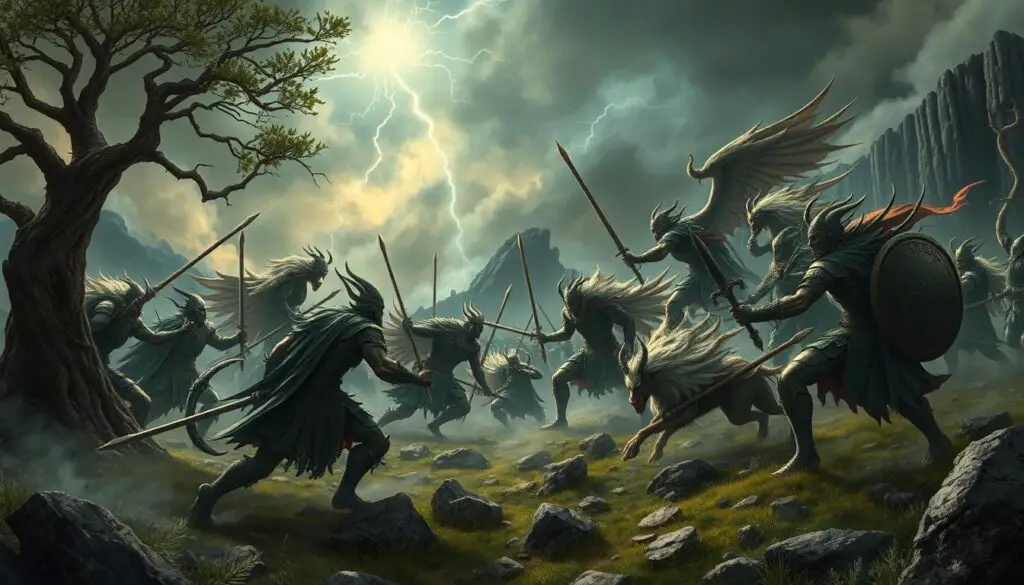
The Irish myths show us the big conflicts between the Fomorians and the Tuatha Dé Danann.
These battles are key to understanding the fight between chaos and order in ancient stories.
The Battle of Mag Tuired
The Battle of Mag Tuired is a major highlight in these myths. It’s not just a story of war.
It’s a symbol of the fight between chaos and order.
The Tuatha Dé Danann, with their magic and divine strength, challenged the Fomorians’ rule.
Leaders like Indech and Balor led the Fomorians, while Lugh led the Tuatha Dé Danann.
Lugh’s skills were crucial in turning the battle’s tide.
Significance of This Mythological War
The Battle of Mag Tuired is more than a story of strength and tactics. It’s deeply meaningful in Irish myths.
It shows the fight between chaos and order, symbolized by the Fomorians and the Tuatha Dé Danann.
Winning, the Tuatha Dé Danann showed the power of order over chaos.
This story is a key part of many myths, showing humanity’s quest for balance and peace in a chaotic world.
Important Figures Among the Fomori
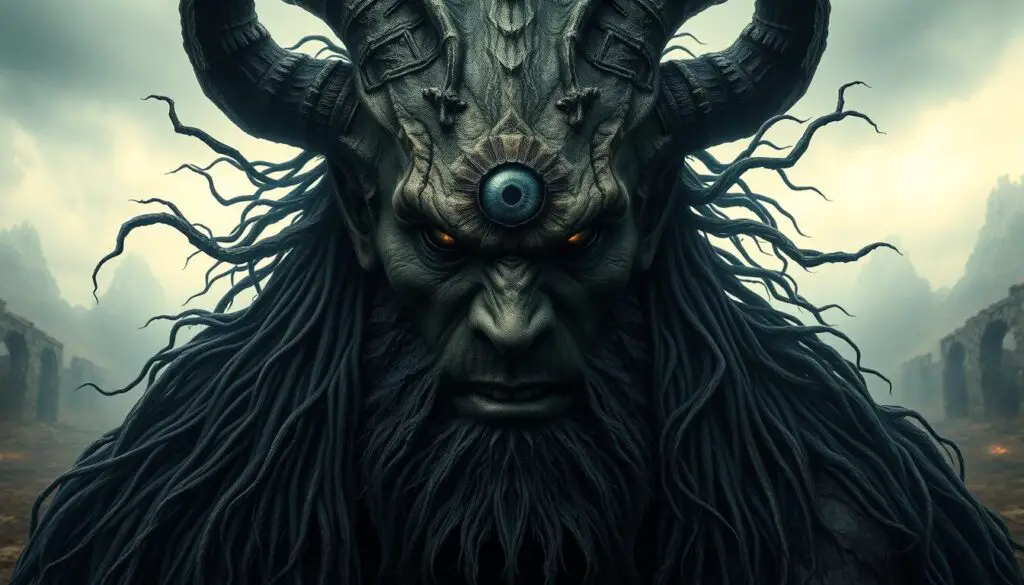
The Fomorians are known for their chaotic nature in Irish mythology.
Two figures stand out: Balor of the Evil Eye and Elatha, the Beautiful Prince. They show the diversity and supernatural background of the Fomorian legends.
Balor of the Evil Eye
Balor is feared for his destructive power among Celtic deities. His eye could destroy anything it looked at. This shows his power and the fear he inspired in others.
His eye could only open with help from his servants. This meant his enemies knew to fear his wrath.
Elatha: The Beautiful Prince
Elatha is known for his beauty and royal behavior. Unlike Balor, he was a noble Fomorian.
Elatha was respected and admired, even by his enemies.
His beauty and leadership set him apart. He and Balor show the complex nature of the Fomorians.
They highlight the supernatural ancestry and roles of these Celtic deities in myths.
Fomori: Their Role as Ancient Symbols of Chaos
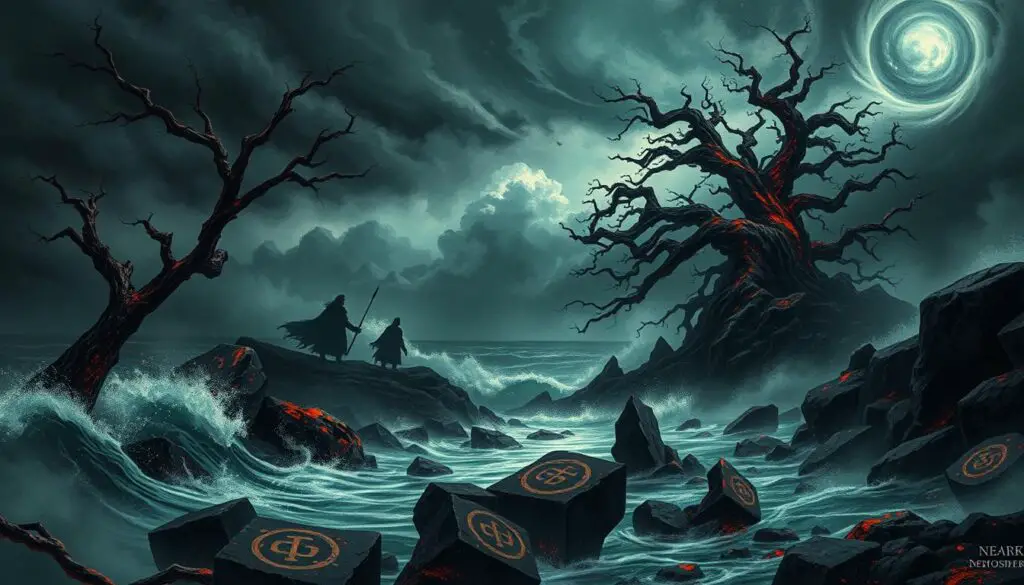
In Irish legends, the Fomori are symbols of chaos and disorder. They represent destructive forces like blight and drought.
This shows the ancient people’s fear and respect for nature’s power.
Personifications of Natural Forces
The Fomorians are among the oldest and strongest in Irish mythology.
They were first seen as evil spirits living under the sea. Over time, they became monsters, showing the dangers of nature.
They were described as having one eye, one arm, and one leg. This looked like deformity and chaos.
It reminded people of nature’s unpredictable and destructive side.
Representations in Literature and Art
Throughout history, the Fomorians were seen as powerful enemies in stories and art.
They fought against Ireland’s settlers, like the Tuatha Dé Danann. Old stories and myths show them as sea raiders and giants, influenced by Viking attacks.
Not all Fomorians were seen as monsters. Some, like Elatha, were beautiful and noble.
This shows their complex nature in stories about chaos and order.
Fomori and the Early Settlers of Ireland
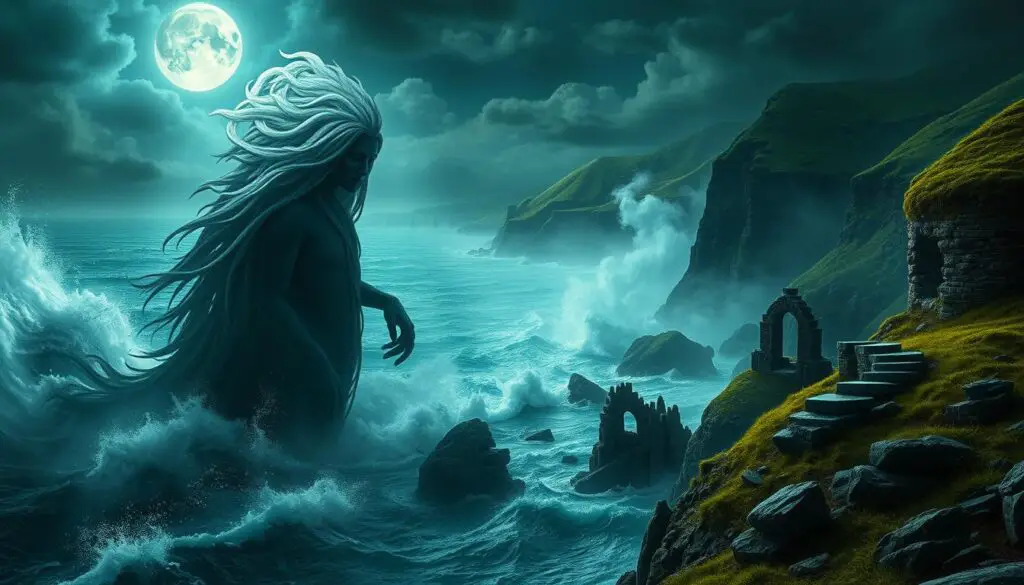
The Fomori, a mysterious group in Irish myths, are deeply linked to the early settlers of Ireland.
These myths tell of interactions with Fomori that often challenged the settlers.
They are highlighted in stories about Partholón and Nemed, who led their people to Ireland.
Interactions with Partholón and Nemed
Partholón’s arrival in Ireland marked one of the earliest interactions with Fomori.
At the Battle of Magh Ithe, he faced Cichol Gricenchos and 800 followers.
Despite being outnumbered, Partholón’s nearly 10,000 followers stood strong against the Fomori.
Nemed’s battle with the Fomori was even more brutal. He led about 60,000 people against the Fomorians, leading to heavy losses.
The Fomori’s rule over the Nemedians sparked a rebellion. Only 30 Nemedians survived a sea battle, showing the Fomori’s strength.
Influence on Prehistoric Monuments
The Fomori’s influence goes beyond war; their legacy is seen in prehistoric Irish monuments.
These structures are linked to the Fomori by legend. Their powerful presence and architectural skills left a mark, blending myth with real craftsmanship.
The stories say the Fomori helped create these ancient sites. Prehistoric Irish monuments like Newgrange and the Hill of Tara have tales that hint at supernatural involvement.
These stories suggest these places were made with the Fomori’s help or resistance.
Modern Interpretations and Cultural Impact
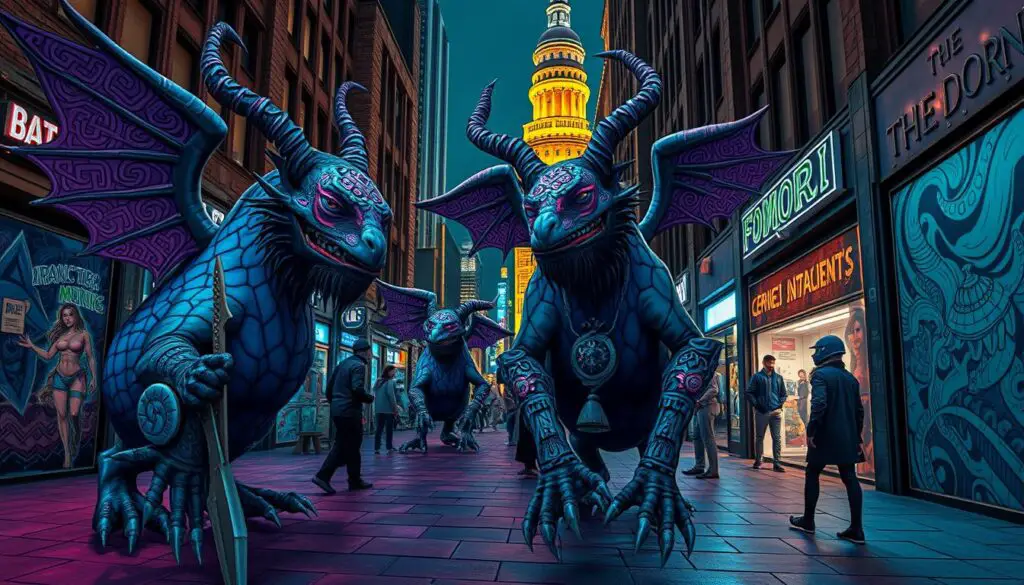
The Fomori, once mysterious beings from Irish legend, now shine in today’s media and culture.
They show how ancient stories still touch our lives. Their stories weave into modern tales, proving their lasting impact.
The Fomori have adapted amazingly in today’s media. Originally seen as sea raiders and giants, they now appear in books, movies, and games.
For example, Ruhan of the Fomori in Magic: The Gathering (MTG) brings out their wild side, thrilling fans everywhere.
Depictions in Contemporary Media
The Fomori’s influence goes beyond old tales into various media. In a special MTG drop, Ruhan of the Fomori shows their powerful and unpredictable nature.
Other cards, like Inkshield and Teferi’s Protection, add to their story, showing themes of protection and balance.
Fomori in Popular Culture
The Fomori’s impact is seen in many forms of media. Shields in their stories symbolize more than just defense.
They stand for divine power, cultural identity, and control over the universe.
This idea is seen in myths from Greece, Norway, and Ireland, where shields have magical and godly powers.
Shields in myths link the Fomori to big cultural ideas. They show how old stories can inspire new ones, keeping the Fomori relevant today.
With themes of honor, glory, and divine power, they still capture our imaginations.
Conclusion
The Fomori are a key part of Irish folklore, deeply linked to the land’s history and culture.
They come from ancient Irish legends, blending earth and supernatural qualities.
Their stories move between horror and grandeur, showing their power over chaos and nature.
Today, the Fomori still inspire art and culture, proving their lasting impact.
Their tales have moved through time, enriching our understanding of Irish folklore. This shows how myths can stay alive and interesting over many years.
The Fomori’s stories are told through art and symbols, sparking our imagination.
They remind us of Ireland’s magical past. By looking at their roles in myths, we learn more about their importance.
The Fomori connect the old stories to today, proving their lasting place in Irish mythology.
FAQ
What are the origins of the Fomori in Irish folklore?
The Fomori come from Old Irish language and stories. Their name means they might be from the underworld. They were seen as spirits from the deep waters in early tales.
How are the Fomori depicted in ancient Irish myths?
Ancient stories show the Fomori as scary and ugly. They had one eye, one arm, and one leg. They were seen as figures of chaos and control in Irish myths.
What is the significance of the Fomori in the Lebor Gabála Érenn?
In the Lebor Gabála Érenn, the Fomori are big enemies to Ireland’s early people. They show the fight between order and chaos in Irish stories.
How did Viking raids influence the portrayal of the Fomori?
Viking raids made the Fomori seem like sea raiders. This showed real-life battles with Viking invaders in Ireland. Over time, they became seen as giants, showing fears and hero stories.
What are some notable features of the Fomorians’ physical appearance?
The Fomorians are often shown as very ugly. They had one eye, one arm, and one leg. This shows they were linked to chaos and the supernatural in Irish stories.
Who are some prominent figures among the Fomori?
Important Fomorians include Balor of the Evil Eye, who could destroy with his gaze. Elatha, a darkly beautiful leader, shows the mix of evil and power in Fomorian stories.
Can you explain the Battle of Mag Tuired?
The Battle of Mag Tuired was a key fight between the Fomorians and the Tuatha Dé Danann. It shows the big struggle between order and chaos. It’s like other stories of divine wars in other cultures.
How do the Fomori personify natural forces in mythology?
The Fomori stand for forces of nature like blight and chaos. They show the power of nature in a way that was both respected and feared by ancient people.
What impact did the Fomori have on prehistoric Irish monuments?
Stories say the Fomori might have helped build old Irish monuments. These tales mix the magical with the real past, showing the deep spiritual history of early Irish people.
How are the Fomori depicted in modern media and popular culture?
Today, the Fomori appear in movies, books, and art. They show how well they can fit into stories. They keep drawing people in with their timeless fight between chaos and order.
What does the name ‘Fomori’ signify in its etymological roots?
‘Fomori’ comes from Old and Middle Irish. “Fo” means “under” or “beneath.” The rest of the name can mean sea or demons, showing their deep and chaotic nature.


